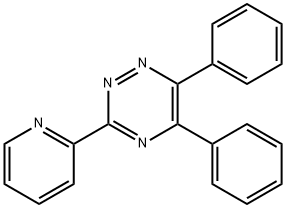| Identification | More | [Name]
3-(2-PYRIDYL)-5,6-DIPHENYL-1,2,4-TRIAZINE | [CAS]
1046-56-6 | [Synonyms]
3-(2-PYRIDYL)-5,6-DIPHENYL-1,2,4-TRIAZINE
5,6-DIPHENYL-3-(2-PYRIDYL)-1,2,4-TRIAZINE
PDT
TIMTEC-BB SBB008869
1,2,4-Triazine, 5,6-diphenyl-3-(2-pyridinyl)-
4-triazine,5,6-diphenyl-3-(2-pyridinyl)-2
5,6-Diphenyl-3-(2-pyridinyl)-1,2,4-triazine
as-Triazine, 5,6-diphenyl-3-(2-pyridyl)-
5,6-Diphenyl-3-(2-pyridyl)-1,2,4-triazine~PDT
3-(2-PYRIDYL)-5,6-DIPHENYL-1,2,4-TRIAZIN E, 99+%
3-(2-PYRIDYL)-5,6-DIPHENYL-1,2,4-TRIAZINE (PDT)
3-(2-PYRIDYL)-5,6-DIPHENYLTRIAZINE
3(2-PYRIDYL)-5,6-DIPHENYL-1,2,4-TRIAZINE extrapure AR
3-(2-Pyridinyl)-5,6-diphenyl-1,2,4-triazine
3-(2-Pyridinyl)-5,6-diphenyl-as-triazine | [EINECS(EC#)]
213-878-7 | [Molecular Formula]
C20H14N4 | [MDL Number]
MFCD00006462 | [Molecular Weight]
310.35 | [MOL File]
1046-56-6.mol |
| Safety Data | Back Directory | [Hazard Codes ]
Xi | [Risk Statements ]
R36/37/38:Irritating to eyes, respiratory system and skin . | [Safety Statements ]
S26:In case of contact with eyes, rinse immediately with plenty of water and seek medical advice .
S36:Wear suitable protective clothing . | [WGK Germany ]
3
| [RTECS ]
XY8598150
| [TSCA ]
Yes | [HS Code ]
29336990 |
| Hazard Information | Back Directory | [Chemical Properties]
yellow powder | [Uses]
3-(2-Pyridyl)-5,6-diphenyl-1,2,4-triazine was employed as chromogenic-extraction reagent during spectrophotometric determination of iron in acids and acidic solutions. It was also employed as precolumn derivatizing reagent in the HPLC method with UV absorbance detection for the Fe(II) determination. | [Definition]
ChEBI: 5,6-diphenyl-3-(2-pyridyl)-1,2,4-triazine is a member of 1,2,4-triazines. | [Indications]
PDT with 20% ALA may be used for the treatment of actinic keratoses. The product is marketed as Levulan Kerastick (DUSA Pharmaceuticals, Valhalla, New York). The ALA is applied diffusely over the field with an applicator; the patient returns 1 to 3 hours later and is exposed to an activating light source. Once exposed to the light, ALA produces singlet oxygen, which damages the cell membrane. Sixty-six percent of patients had total clearing of lesions at 8 weeks using blue light exposure for 15 minutes. Patients experience a burning pain but heal with an excellent cosmetic result. Photosensitivity lasts for 24 hours. An optional regimen is to apply ALA only to visible actinic keratoses; however, this method will not treat subclinical lesions. A variety of lasers and light sources can be used to activate the ALA, including blue light, yellow light, and broadband light; however, many details remain to be worked out, such as the optimal incubation times for the ALA when using each of the various light sources. | [General Description]
3-(2-Pyridyl)-5,6-diphenyl-1,2,4-triazine (PDT) reacts with Cu(II) perchlorate in ethanol to yield [Cu(PDT)2(ClO4)2]. | [Purification Methods]
Purify it by repeated recrystallisation from EtOH/dimethylformamide. It is a reagent for estimating Fe(II) and Ru(II). [Chriswell & Schilt Anal Chem 46 992 1974, Kamra & Ayers Anal Chem 78 423 1975.] |
| Spectrum Detail | Back Directory | [Spectrum Detail]
3-(2-PYRIDYL)-5,6-DIPHENYL-1,2,4-TRIAZINE(1046-56-6)MS
3-(2-PYRIDYL)-5,6-DIPHENYL-1,2,4-TRIAZINE(1046-56-6)1HNMR
3-(2-PYRIDYL)-5,6-DIPHENYL-1,2,4-TRIAZINE(1046-56-6)13CNMR
3-(2-PYRIDYL)-5,6-DIPHENYL-1,2,4-TRIAZINE(1046-56-6)IR1
3-(2-PYRIDYL)-5,6-DIPHENYL-1,2,4-TRIAZINE(1046-56-6)IR2
3-(2-PYRIDYL)-5,6-DIPHENYL-1,2,4-TRIAZINE(1046-56-6)Raman
|
|
|





